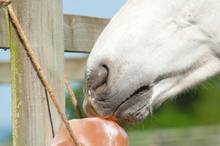Newsdate: Thursday, June 23, 2022, 10:00 am
Location: BLISSFIELD, Michigan
Everyone looks forward to the warm weather as the ideal time to ride or work their horse. Most understand the dangers of working the horse under conditions of high heat and humidity. However, horses can be compromised easily under less than sweltering conditions if you do not know how to correctly protect them.

Horse licking a salt block
Signs of inadequate hydration in equines include poor exercise tolerance, cramping, or apparent weight loss (actually water loss) and decrease in sweat.
Horses control their body temperature primarily by sweating. In warmer weather, it becomes crucial to support and maintain proper hydration, whether doing endurance training, events, trail rides, or standing in a field in hot weather.
Hydration isn't just about water intake or loss
Sweating also causes significant losses of salt. Losing both can lead to devastating consequences. Horses can lose water volume up to 4 gallons per hour, and as much as 4 ounces of salt per hour.
The Sodium in salt, which is Sodium Chloride, is absolutely essential for the horse's body to retain normal, healthy levels of water. Regardless of how much water the horse drinks, he will not be able to retain a normal amount of water in the body without adequate Sodium, or salt.
The brain reads Sodium levels in the blood to stimulate the horse to drink when it needs hydration. When water levels drop and Sodium concentration rises, the horse is signaled to drink. However, before any changes in water or Sodium levels in the blood can occur, the body will pull what it needs out of the tissues to maintain blood levels.
This can, and does, result in inadequate hydration levels at the tissue level before it shows up in the blood.
The signs of inadequate hydration in equines
The consequences of this include poor exercise tolerance, cramping, or apparent weight loss (actually water loss). Sweat production may decrease. Exercising horses and lactating mares are at particularly high risk.
To monitor for proper hydration, do the skin pinch test. A fold of skin on the neck lifted away from the body should snap back into place quickly when you let go. Somewhat more reliable is the capillary refill time. Press a finger firmly against the gum above the upper teeth. The white indentation this makes should return to a pink color again in 1.5 seconds or less.
As hydration levels lower, the interior of the mouth will begin to feel tacky. Urine production drops and urine becomes darkly colored.
Keeping your horse hydrated
Unlimited clean water must be available at all times. Let the horse drink freely, especially after exercise. Have a salt block or loose coarse salt available at all times. Also add 1 to 2 ounces per day to grain feeds, or dissolve and spray on hay.
Once the horse's basic needs are met with the 1 to 2 ounces per day of plain salt, attention shifts to replacing electrolytes lost in sweat. Sodium and Chloride are the major losses here too, but Potassium is also lost in significant amounts.
Paste electrolytes that provide quick support in these situations should therefore contain generous Potassium, and Calcium and Magnesium, as well. Potassium, because it is absorbed rapidly and excess is quickly depleted, Magnesium, because it is often low in horses to begin with, and low Calcium due to acid-based abnormalities.
The 2-2-2 Rule
Close attention to the horse's hydration is the most important factor in maintaining health and performance in the summer. A good rule of thumb for horses in work in hot weather is:
- 2 ounces of plain salt, source of the electrolytes Sodium and Chloride, the night before work
- 2 ounces of plain salt the morning of the work day
- For horses working longer than 2 hours/day in the heat, also add 2 ounces of a balanced electrolyte supplement containing Potassium for every hour worked over the 2 hour mark.
Plain salt provides the most important two electrolytes - Sodium and Chloride. Potassium lost in sweat is met by Potassium fed in hay when working less than 2 hours per day.
Salt should be fed with meals or dissolved and sprayed on hay in order to monitor their intake. If only using a block, divide the weight of the block by the number of days it lasts for average daily intake.
About Dr. Kellon
Dr. Eleanor Kellon is staff veterinary specialist for Uckele Health & Nutrition. An established authority in the field of equine nutrition for over 30 years, Dr. Kellon is co-owner of the Equine Cushings and Insulin Resistance (ECIR) group, whose mission is to improve the welfare of horses with metabolic disorders via a unique interface between research and real-life clinical experience. Prevention of laminitis is the ultimate goal.
About Uckele Health & Nutrition
Article by: Dr. Eleanor Kellon, Staff Veterinary Specialist for Uckele Health & Nutrition
